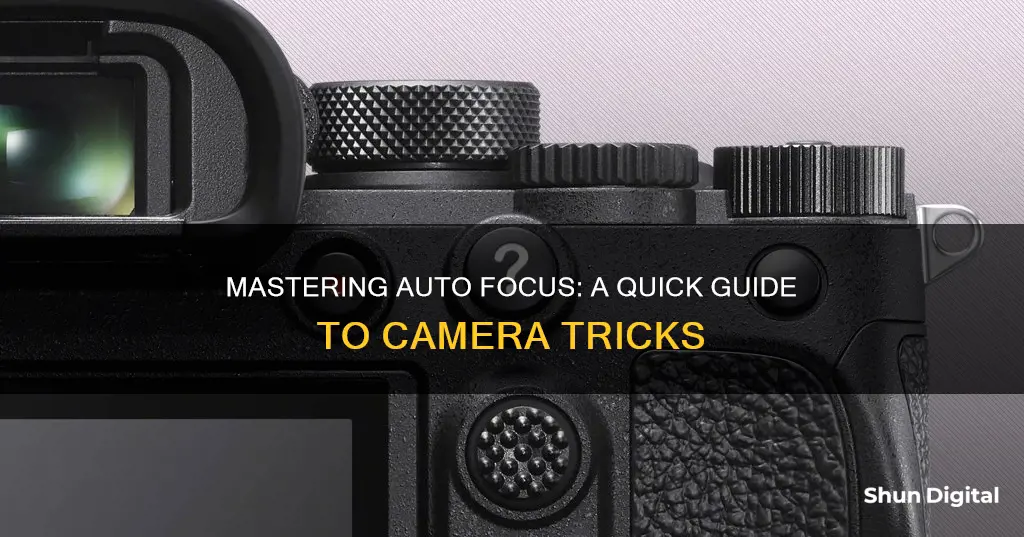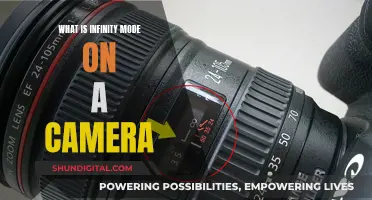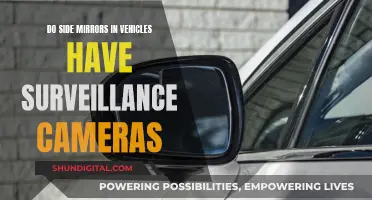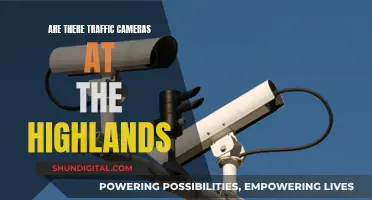
Autofocus is a feature on most modern cameras that allows the camera to automatically focus on the subject matter in the frame. There are two types of autofocus systems: active and passive. Active autofocus systems work by emitting a signal (such as an ultrasonic sound wave or an infrared light beam) and calculating the distance to the subject based on the time it takes for the signal to bounce back. Passive autofocus systems, on the other hand, determine the distance to the subject by analysing the image itself and looking for areas of high contrast. Passive autofocus is commonly found on more expensive single-lens reflex (SLR) cameras, while active autofocus is typically used on less expensive point-and-shoot cameras.
| Characteristics | Values |
|---|---|
| Type | Active or Passive |
| Active AF System | Emits a signal to illuminate or estimate distance to the subject |
| Passive AF System | Uses contrast sensors within the camera |
| Passive AF System | Uses phase detection |
| Passive AF System | Uses contrast detection |
| Active AF System | Emits a red beam on the subject |
| Active AF System | Bounces a sound wave off the subject |
| Active AF System | Emits an infrared signal |
| Active AF System | Emits pulses of infrared light |
| Passive AF System | Analyses the image itself |
| Passive AF System | Analyses the light that comes into the lens |
| Passive AF System | Analyses the central portion of the image |
What You'll Learn

Active vs Passive Autofocus
To engage autofocus on most cameras, you can simply press a button, and the camera will focus on your chosen subject.
Now, onto the differences between active and passive autofocus.
Active autofocus (AF) systems work by emitting a signal, such as an ultrasonic or infrared beam, towards the subject. The signal is reflected back to the camera's focus sensor, and the distance to the subject is calculated based on the time it took for the signal to return. This method is similar to sonar and radar technology. Active AF is useful in low-light environments but is limited to stationary subjects and those at close range.
On the other hand, passive AF systems work by detecting contrast. They either use phase detection or contrast detection to achieve focus. Phase detection splits the incoming light into pairs of images and compares them to calculate the distance to the subject. Contrast detection, on the other hand, measures the intensity of light within a sensor field and adjusts the focus until maximal contrast is achieved. Passive AF systems generally require more light to function effectively.
While active AF is considered more accurate and can be used in low-light conditions, it has some limitations. It may struggle with subjects that are very close to the camera, and it cannot focus through windows or other transparent obstacles. On the other hand, passive AF systems are generally faster and more versatile, as they can focus through windows and work with a wider range of lenses. However, passive AF may struggle in low-light conditions or with surfaces that have low contrast or repeating patterns.
To address the limitations of both systems, some cameras employ a hybrid autofocus system, combining active and passive methods or phase detection and contrast measurement. This allows for increased accuracy, speed, and reliability.
Motorola Focus 66: How Long Does the Charge Last?
You may want to see also

Phase Detection vs Contrast Detection
There are two main types of autofocus systems used in modern cameras: phase detection and contrast detection. Each system has its own strengths and weaknesses, and the type of photography you are shooting will determine which is best to use.
Phase Detection
Phase detection autofocus (PDAF) is generally considered faster and more accurate than contrast detection, especially when tracking moving subjects. This system is found in digital SLRs and some mirrorless cameras. It works by using two sensors on each side of the camera lens to detect the phase difference of the light entering the lens. This allows the camera to determine whether the subject is in focus and adjust the lens accordingly.
Phase detection is also good in low-light conditions as the sensors can detect light directly from the lens. It is also very customisable, allowing photographers to change the focus points and sensitivity to their preferences.
However, phase detection is more prone to errors and internal misalignment issues.
Contrast Detection
Contrast detection autofocus (CDAF) is the system used by most mirrorless cameras, point-and-shoot cameras, and DSLR cameras in live view. It is also the system used by smartphone cameras. CDAF is generally more precise than phase detection as it uses the camera's sensor to detect the contrast between light and dark areas in the scene. The camera's processor then aligns the lens to bring the subject into focus.
CDAF is also quieter than PDAF, making it ideal for photographing skittish animals or in quiet environments.
The downside of contrast detection is that it requires the camera to process more data, which means it takes longer to lock focus. As a result, it is not good at tracking moving subjects.
Hybrid Autofocus
Some mirrorless cameras now come with hybrid autofocus systems that combine both PDAF and CDAF. This provides greater control and flexibility, allowing photographers to track moving subjects with phase detection and focus on stationary subjects with contrast detection.
Best Battery-Powered Cameras: Uninterrupted Photography
You may want to see also

Autofocus Area Modes
There are several autofocus area modes to choose from, each with its own advantages and disadvantages. Here is an overview of some of the most common autofocus area modes:
- Single-Point autofocus: The camera uses a single focusing point, selected by the user, to autofocus. This mode is suitable for situations where the camera and subject are stationary, and no tracking capabilities are needed. It can be used with continuous autofocus, but it is not suitable for tracking fast-moving objects across multiple points.
- Dynamic autofocus: The user selects a single focusing point, but the camera can also track the subject if it moves into some of the surrounding points. The number of surrounding points the camera pays attention to can usually be specified. This mode is well-suited for wildlife photography.
- 3D Tracking autofocus: The camera follows the subject as it moves across different focusing points. Unlike Dynamic AF-Area mode, the user is not expected to pan the camera to keep the subject close to the initially selected point. While this mode is also suitable for wildlife photography, it may not be as quick or accurate as the simpler Dynamic AF-Area mode.
- Group-Area autofocus: The camera uses multiple autofocus points simultaneously, usually five. It gives equal priority to all the points and focuses on the nearest object located on any of them. This mode is useful for challenging autofocus situations, such as photographing a fast-moving bird in flight.
- Auto-Area autofocus: The camera automatically scans the scene and decides on the subject to focus on, often the closest object to the camera or a face. This mode gives the user less control and is, therefore, not recommended.
Not all cameras have every one of these autofocus area mode options, and some may have additional modes as well. The specific names of these modes may also differ depending on the camera model.
The Rarest Catch: 1967 Camaro SS Convertibles
You may want to see also

Continuous vs Single-Servo Autofocus
When it comes to autofocus, most cameras have two main autofocus "drive" modes: single-servo autofocus and continuous-servo autofocus. Some cameras also have a third mode: auto-servo autofocus.
Single-Servo Autofocus
Single-servo autofocus, also known as One-Shot (Canon) and AF-S (Nikon), is ideal for stationary subjects. Once the camera has acquired focus, it will not readjust until you let go of the focusing button. In other words, when you press or half-press the shutter button, the camera will focus on the subject once and lock that focus until you take your finger off the shutter release button. This is also known as focus lock.
Single-servo autofocus is also useful when you want to recompose your shot after focusing. You can achieve focus lock on your subject, then let go of the shutter button and recompose your shot, without the camera refocusing.
Continuous-Servo Autofocus
Continuous-servo autofocus, also known as AI Servo (Canon) and AF-C (Nikon), is ideal for photographing moving subjects. In this mode, the camera continuously adjusts focus whenever you hold down the focusing button. This means that if your subject or the camera is moving, the autofocus will continually change focus to keep the subject sharp.
Continuous-servo autofocus is also useful when shooting at very shallow apertures (e.g. f/1.4) and close-up situations. In these conditions, even the slightest movement can throw the subject out of focus, so continuous autofocus can help to keep the subject sharp.
Auto-Servo Autofocus
Some cameras have a third autofocus mode: auto-servo autofocus. This mode automatically switches between single-servo and continuous-servo autofocus depending on whether the camera detects that the subject is moving or not.
Continuous-servo autofocus is recommended for most images, especially wildlife or sports photography. Single-servo autofocus is ideal for typical landscape and architectural photography, where the subject and camera are completely still.
Smoke Detector Camera Batteries: How Long Do They Really Last?
You may want to see also

Autofocus Video Cameras
Autofocus is a comparatively new invention in the history of photography, first appearing on the market in 1977. Today, most cameras have autofocus capabilities, with the exception of some manual vintage lenses. Autofocus works either by using contrast sensors within the camera (passive AF) or by emitting a signal to illuminate or estimate the distance to the subject (active AF).
There are two types of autofocus modes: single AF and continuous AF. Single AF is used for static subjects and stops focusing once it has focused on the subject. Continuous AF, on the other hand, is used for moving subjects and continuously adjusts the focus to ensure a sharp image.
When it comes to choosing a camera with autofocus, there are a few factors to consider. Firstly, decide on your budget. If you are a casual photographer, a bulkier DSLR might be a good option. However, if you want something more compact, there are many options available, including mirrorless cameras.
Another factor to consider is the type of autofocus system the camera uses. The two main types are phase detection and contrast detection. Phase detection is faster and better at tracking moving subjects, while contrast detection tends to be more precise and is better suited for non-moving subjects.
- Sony Alpha ZVE10 II: a mirrorless interchangeable lens camera with fast hybrid autofocus.
- Nikon Z f: a mirrorless camera with autofocus built from Deep Learning technology.
- Panasonic Lumix S5 II: a mirrorless camera with phase detection AF and uncropped 6K video capabilities.
- Sony A7S III: a full-frame camera with class-leading autofocus and 4K video capabilities.
- Fujifilm X-H2S: a hybrid camera with impressive autofocus and 6K video recording.
- Sony ZV-E1: a full-frame vlogging camera with excellent autofocus and AI smarts.
- Nikon Z9: a full-frame flagship camera capable of shooting 8K/30p video with reliable Eye AF tracking.
Fight School Zone Camera Tickets: Know Your Rights
You may want to see also







